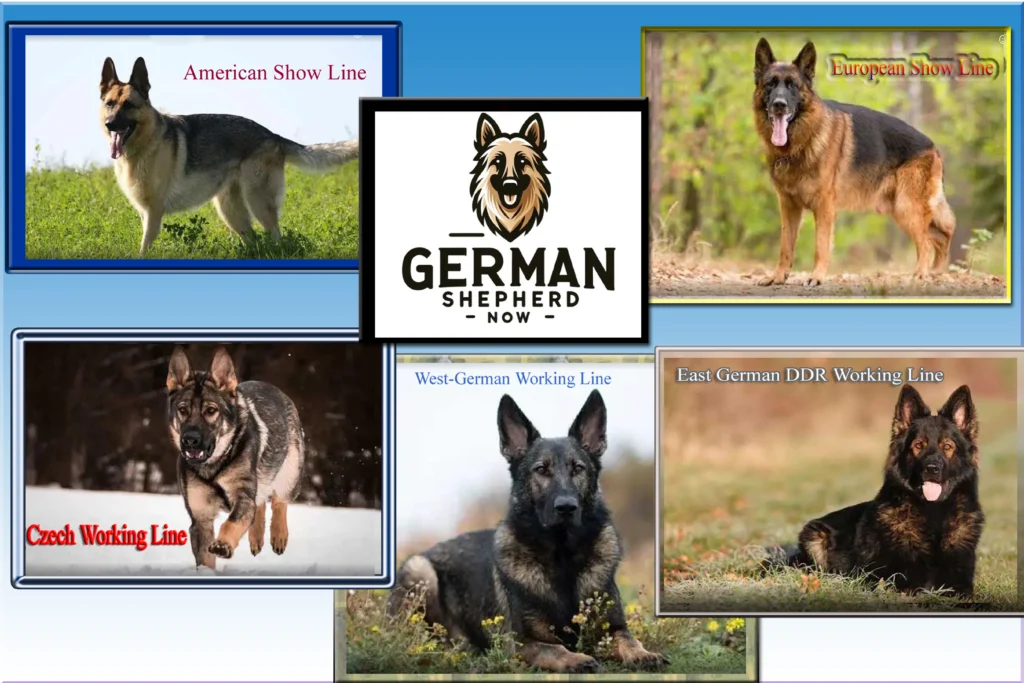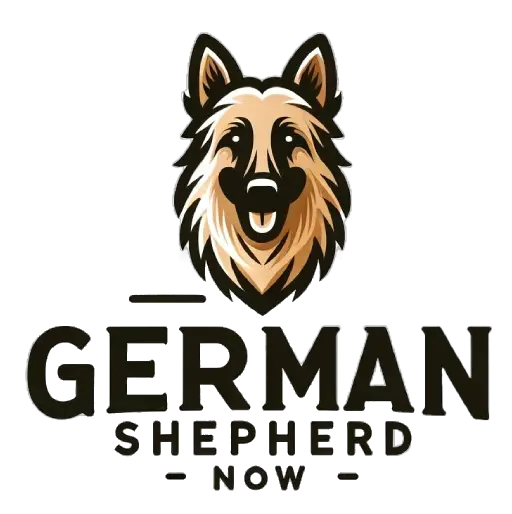German Shepherd Breeds
German Shepherds are not just a single breed but a group with five distinct types, each bred with unique traits and purposes.
Here are the five known types:
- West-German Working Line: Known for intelligence and a wolf-like look. They’re versatile and can work in many environments.
- East German DDR Working Line: These dogs are loyal and brave with giant heads and strong muscles.
- Czech Working Line: Bred in the Czech Republic, they’re energetic and agile with an angular head.
- American Show Line: Popular in the U.S. and Canada, they have a mix of features with a shorter muzzle and unique walking style.
- European Show Line: Often seen as the most beautiful, with black and red fur and a larger size.
There are two main groups: working lines, focused on skills and abilities, and show ropes, bred for their appearance.

West-German Working Line
Compared to the West German Show Lines, the West German working lines emphasize ability, drive, and temperament more than following the breed standards.
These canines are believed to represent the original German herding breeds and are highly skilled in roles that require protective instincts, like law enforcement, military services, and service-oriented positions.
They possess a balanced blend of physical and temperamental traits and exhibit high intelligence and trainability.
Their optimal drive and disposition make them great for guiding visually impaired individuals, participating in search and rescue missions, or providing therapeutic support.
The working ethics and competencies of these animals are truly unparalleled.
East German DDR Working Line
The East German Shepherd, also known as the DDR Shepherd, was meticulously developed in East Germany to exhibit very high working drives and superior athleticism, making them well-suited for intense roles.
Their muscular yet agile physique, bravery, and unparalleled tracking and protection abilities rendered them outstanding in challenging duties.
Competitions in Schutzhund, a sport designed to test these exact capabilities, often showcase their skills.
While their counterparts from West German working lines also demonstrate proficiency in various tasks, the distinctive selective breeding of the DDR Shepherds endows them with unique capacities as working dogs.
Czech Working Line
With their straight backs, compact, muscular frames, and unlimited endurance, Czech Working Line Shepherds are exemplary workers.
Bred for working ability and temperament, these dogs are competent and trainable for intense protection roles and police and military jobs.
Despite their non-standard appearance, this line’s versatility, work ethic, and increasing popularity emphasize the importance of working ability over aesthetics.
American Show Line
The American German Shepherd Show Line was developed by selecting traits that lead to success in American canine exhibitions and adherence to breed standards.
There are certain breeds of dogs, commonly referred to as AKC lines, that are easily identifiable by their sloping back and noticeable angulation.
These traits are highly valued in dog shows, but the emphasis on physical appearance has led to specific health issues, including an increased risk of hip dysplasia.
While working-line dogs are selected based on their ability to perform particular tasks, American Show Line dogs are primarily chosen for their attractiveness and ability to meet physical standards, making them popular for families looking for pets.
European Show Line
The European Show Line German Shepherds, renowned for their poised demeanor and striking appearance, epitomize the breed’s show qualities.
Bred primarily for conformation to the breed standard, these Shepherds exhibit a graceful structure with harmonious proportions, a calm and confident temperament, and a lustrous coat in various colors.
While they maintain the intelligence and versatility of their working counterparts, European Show Lines are less driven by their intense work ethic, making them well-suited as family companions.
Their balanced nature and sociability make them a preferred choice for those valuing aesthetics and the classic Shepherd temperament.
Mixed Lines of German Shepherds
Interbreeding among this breed’s diverse lines has resulted in various mixed-line canines.
These hybrids inherit a blend of characteristics from their multifaceted ancestry, showcasing the versatile nature of the species.
Mixed-line descendants may exhibit a spectrum of coat colors, including black and red, black and tan, sable, or solid black, while their behavioral traits remain just as varied.
Prospective owners should thoroughly investigate the parents’ lineage and carefully consider their own lifestyle needs before welcoming one of these distinctive and versatile companions into their home.
The key differences between the various German Shepherd breeds:
| Breed Line | Appearance | Temperament | Primary Use | Training & Socialization | Health & Lifespan | Grooming | Availability |
| American Show Line | Sleek, show-quality looks with a sloped back and refined features. | Balanced, adaptable, good in families, less intense than working lines. | Mainly for show rings and companionship, with less focus on work traits. | It needs mental and physical stimulation and thrives on interaction. | Prone to breed-specific health issues, lives around 7-10 years. | Regular brushing and grooming are required due to a thicker coat. | Very popular in the U.S. and widely available. |
| West German Show Line | Rich coloration, straighter back than American lines, balanced body. | Confident, even-tempered, versatile for show and companionship. | Show and family life can work but not as intense as working lines. | Requires balanced training and socialization. | Health is similar to American lines, with some genetic issues. | Routine grooming is similar to American lines. | Popular in Europe, available in the U.S. |
| West German Working Line | More muscular and less angulated, built for functionality. | Energetic, driven, high working ethic, more demanding temperament. | Focused on working capabilities: herding, protection, and service. | High training is needed for physical and mental well-being. | Generally robust, may live longer due to fewer show line issues. | Regular maintenance and less grooming than show lines. | Valued by working dog handlers, somewhat available. |
| DDR/East German Working Line | Solid, heavier build with dark pigmentation, utilitarian look. | Strong nerves, very protective, highly trainable for serious work. | Bred for patrol and protection, with strong guarding instincts. | Intensive training and consistency are crucial. | Usually healthy, with specific care for working dog needs. | Requires routine grooming, especially during shedding | Less common, more sought after for their work abilities. |
| Czech Working Line | Robust, compact, and often darker, reflecting their work origins. | Intense, fearless, and challenging, ideal for police and military work. | Primarily used for active duty in protection and law enforcement. | Demands rigorous training and transparent leadership. | Resilient health and careful breeding reduce hereditary issues. | Regular grooming is needed, potentially a less plush coat. | Less widely available, prized in protection work. |
| European Show Line | Similar to the West German Show but adheres to specific European standards. | Steady and well-mannered, suitable for show and family companionship. | Conformation to breed standards for European show rings. | Regular training and socialization are essential. | Comparable health to other show lines, screening advised. | Grooming needs are consistent with show-line requirements. | Widely accessible in Europe, popularity is growing worldwide. |
Each of these German Shepherd lines has unique traits shaped by their breeding history.
The American and West German Show Lines are bred based on appearance and temperament suitable for show and companionship.
The Working Lines from West Germany, DDR/East Germany, and the Czech Republic are bred for their working capabilities, with more muscular, more robust builds and temperaments suited for active roles such as police, military, and service jobs.
The European Show Line generally conforms to European breed standards and is suitable for shows and as family pets.
Each line has its grooming and healthcare requirements, and availability varies by region and demand.
Lifelong Loyalty: The German Shepherd Experience
Regardless of lineage, shepherds are known for their unwavering loyalty and deep bonds with their owners and families.
Proper training can enhance their innate protectiveness and commitment.
This intuitive breed reciprocates the affection, attention, and respect they receive. With good care, these diligent protectors become steadfast allies.
Tracing the History of German Shepherd Varieties
The breed originated as a herding dog in Germany, where meticulous breeding gave rise to specific lines tailored for show or functional work.
These origins have imbued the breed with signature courage, intelligence, and faithfulness.
Understanding each variant’s pedigree and distinctive characteristics enables prospective owners to choose the Shepherd that aligns with their lifestyle and expectations.
Despite their diversity, these canines remain among the most adaptable and cherished breeds.
Finding the German Shepherd Who Fits You Best
With many Shepherd lines available, investing time to understand their heritage, attributes, and intended roles is critical in selecting a match for your life.
Whether you’re in the market for an energetic, work-oriented dog or a calmer household pet, exploring the nuances of the various lines is crucial.
Investigating the West German Show Lines, East German Working Lines and American Show Lines in depth reveals the subtle differences that make certain Shepherds more suitable for various living environments and family dynamics.
However, irrespective of the line that captures your interest, they all share the robust loyalty and vibrant temperament that has made Shepherds a globally admired breed.
Thus, conducting thorough research is essential to discover an exceptional German Shepherd who will capture your heart and seamlessly integrate into your lifestyle.
